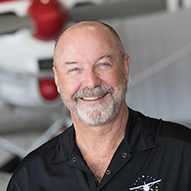Ramone Hemphill
Founder of The 99th Squadron

There was a cousin who flew for the U.S. Navy, now an active airline pilot, and his ROTC instructor. Hemphill is a flattering reflection of those who helped him. Based in Melbourne, Florida, he is a private pilot with an instrument rating and a complex endorsement who is the founder of The 99th Squadron, a 501(c)(3) tax-exempt nonprofit designed to introduce young students, and particularly students of color, to the career opportunities that can be found in aviation.
The organization takes its name from the 99th Pursuit Squadron, the first of four U.S. Army Air Force squadrons that were part of the 332nd Fighter Group, a unit that is more commonly known today as the Tuskegee Airmen.
Each fall The 99th Squadron begins a free five-week curriculum with a series of aviation-related topics on successive Saturdays. With students ranging from the sixth to twelfth grade, the goal isn’t as much to create professional pilots as it is to show that aviation presents myriad opportunities. At the end of the five-week program, Hemphill schedules introductory flights with the students. Often, they are accompanied by family members who are as excited about the possibilities as their young students. the99th.org
How did you get started in aviation? In high school I was part of an Explorers’ club that featured aviation. We visited the air traffic control tower in Charlotte, North Carolina. I spent a few years in Air Force ROTC, and became a systems engineer in avionics and flight controls. I got into flight training to better understand my day job from an operational standpoint, which proved to be an advantage.
What were your biggest challenges? At first, the biggest challenge was learning how to land that airplane! Nowadays, a challenge is sticking to an effective schedule to maintain proficiency, which is a greater commitment than simply keeping up with IFR (and passenger) currency. I budget up to $5,000 a year on aircraft rentals for personal flights, fuel, renters insurance, and memberships. Thanks to my supportive wife and kids, I always find an excuse to fly on a regular basis. But my biggest challenge is getting more African Americans exposed to this vast field of opportunity.
Favorite aircraft? It’s a tough decision between the Cessna 152, the Piper Warrior, and the Piper Arrow III.
Favorite aviation-related activity? Introducing kids to the wonderful world of aviation. I run a five-week curriculum specifically built for that purpose.
Advice for students? Save up ahead of time; at least $5,000 initially as you continue to save throughout training, so that you can fly and fly often to build up the basic principles and muscle memory. Any time an entire week goes by without flying, you are extending the length of your training and therefore, the total cost of your training. Flying at least three times a week is ideal, so be sure to schedule flights for the beginning of the week in case there are cancellations that can be rescheduled later that week.



